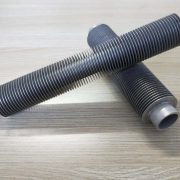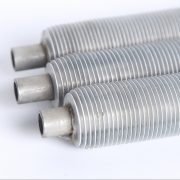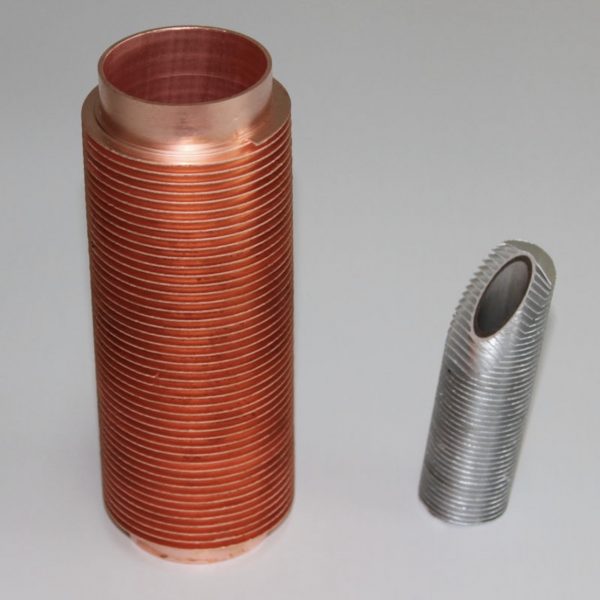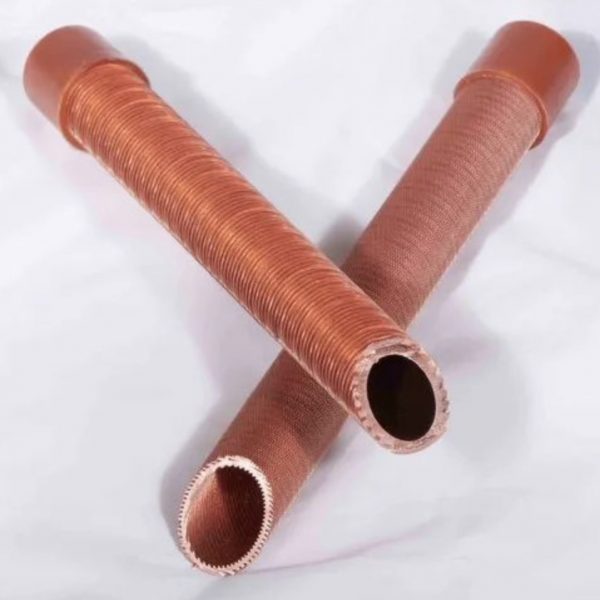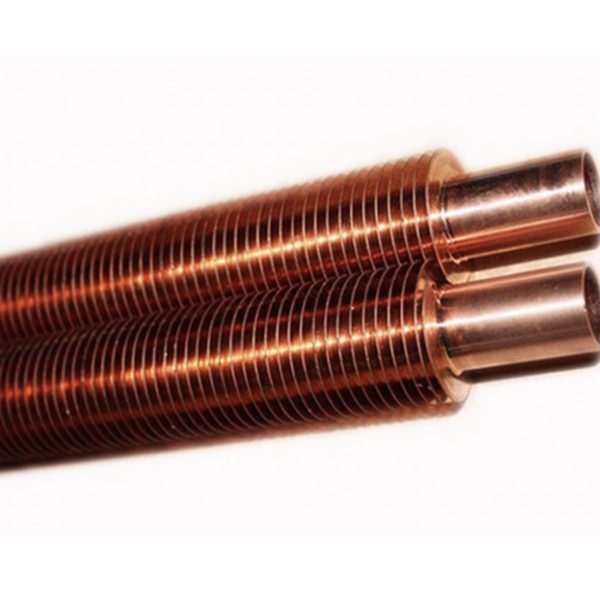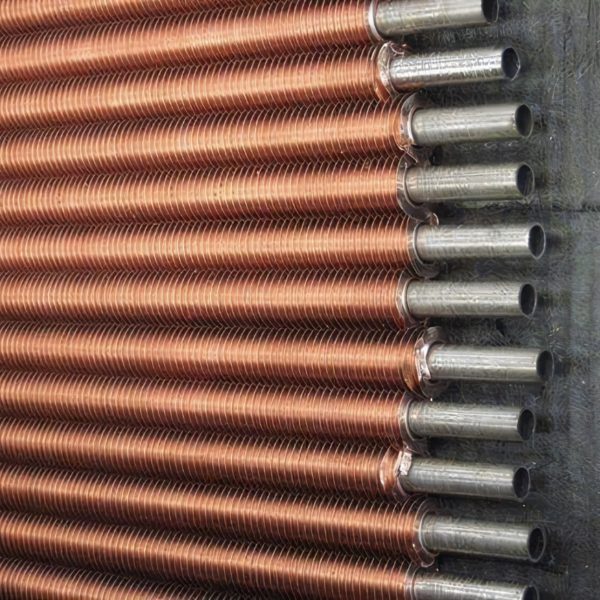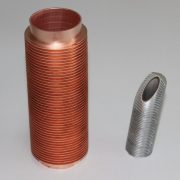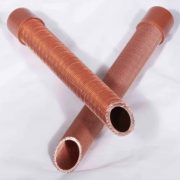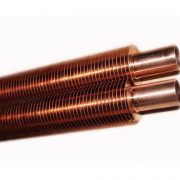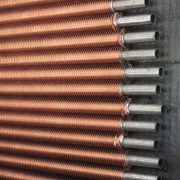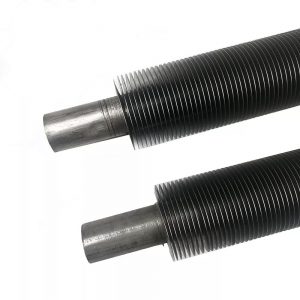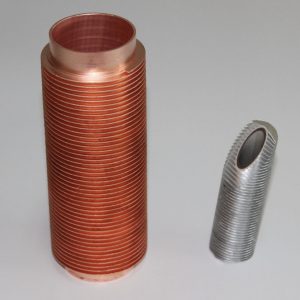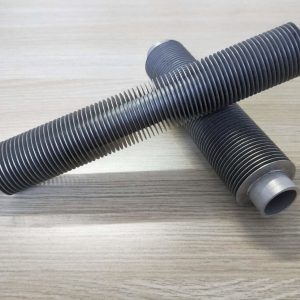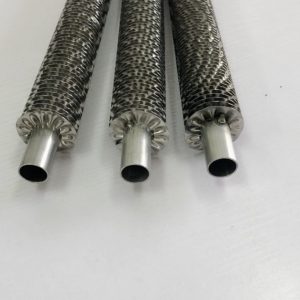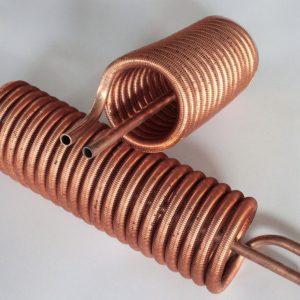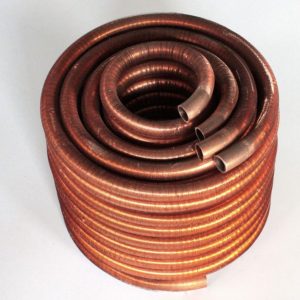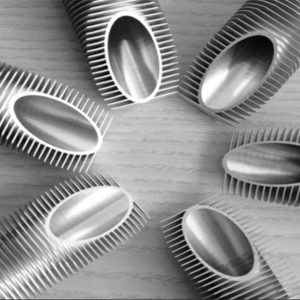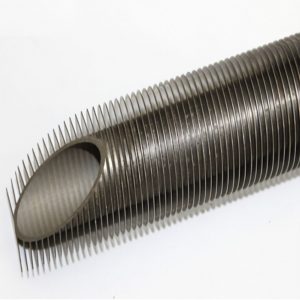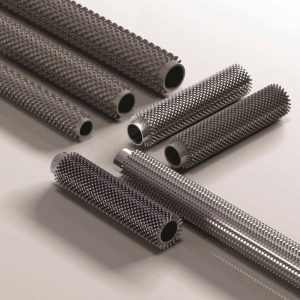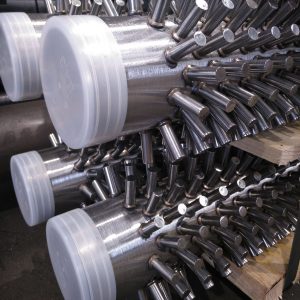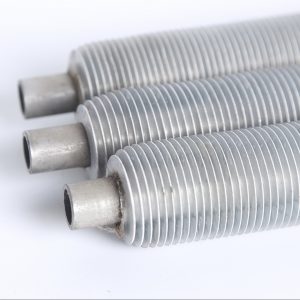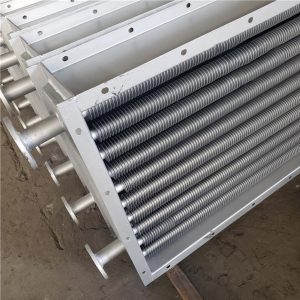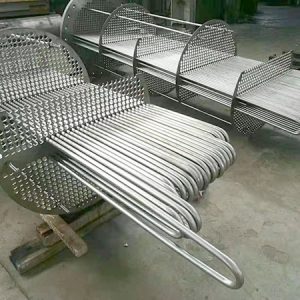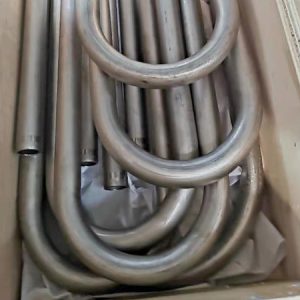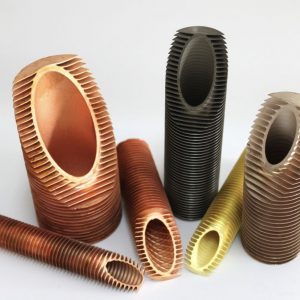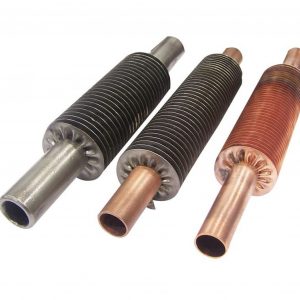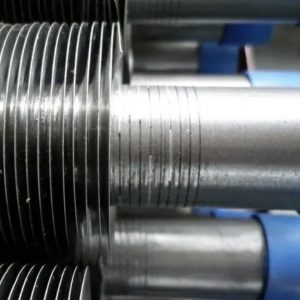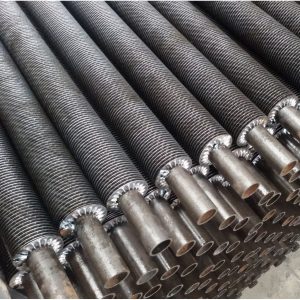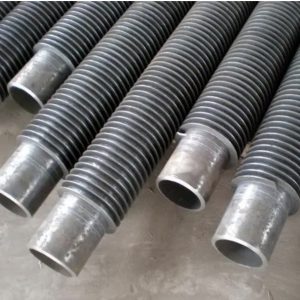Bakır Fin Boru
Bakır metal bir elementtir, ve saf bakır yumuşak bir metaldir. Yüzey, sadece kesildiğinde metalik parlaklığa sahip kırmızımsı turuncu renktedir., ve basit maddesi mor-kırmızıdır. İyi süneklik, yüksek ısı iletkenliği ve elektrik iletkenliği, bu nedenle kablolarda ve elektrikli ve elektronik bileşenlerde en yaygın kullanılan malzemedir..
Aynı zamanda bir yapı malzemesi olarak kullanılabilir ve birçok alaşımdan oluşabilir.. Bakır alaşımları mükemmel mekanik özelliklere ve düşük elektriksel dirençliliğe sahiptir. En önemlileri bronz ve pirinçtir. Ayrıca, bakır aynı zamanda mekanik özelliklerinden ödün vermeden birçok kez geri dönüştürülebilen dayanıklı bir metaldir..
Bakır borular (kırmızı bakır borular olarak da bilinir) musluk suyu borularında yaygın olarak kullanılır, ısıtma ve soğutma boruları, ve farklı ortamlarda kullanılabilir. Bakır borular, soğuk ve sıcak su sistemlerinde metal ve metal olmayan boruların avantajlarını birleştirir. Bakır borular yüksek sıcaklıklara dayanıklıdır ve çeşitli ortamlarda kullanılabilir.. Bununla karşılaştırıldığında, Diğer birçok boru malzemesinin eksiklikleri açıktır.
- Tarif
- The advantages of finned tubes
- Soruşturma
Bakır metal bir elementtir, ve saf bakır yumuşak bir metaldir. Yüzey, sadece kesildiğinde metalik parlaklığa sahip kırmızımsı turuncu renktedir., ve basit maddesi mor-kırmızıdır. İyi süneklik, yüksek ısı iletkenliği ve elektrik iletkenliği, bu nedenle kablolarda ve elektrikli ve elektronik bileşenlerde en yaygın kullanılan malzemedir..
Aynı zamanda bir yapı malzemesi olarak kullanılabilir ve birçok alaşımdan oluşabilir.. Bakır alaşımları mükemmel mekanik özelliklere ve düşük elektriksel dirençliliğe sahiptir. En önemlileri bronz ve pirinçtir. Ayrıca, bakır aynı zamanda mekanik özelliklerinden ödün vermeden birçok kez geri dönüştürülebilen dayanıklı bir metaldir..
Bakır borular (kırmızı bakır borular olarak da bilinir) musluk suyu borularında yaygın olarak kullanılır, ısıtma ve soğutma boruları, ve farklı ortamlarda kullanılabilir. Bakır borular, soğuk ve sıcak su sistemlerinde metal ve metal olmayan boruların avantajlarını birleştirir. Bakır borular yüksek sıcaklıklara dayanıklıdır ve çeşitli ortamlarda kullanılabilir.. Bununla karşılaştırıldığında, Diğer birçok boru malzemesinin eksiklikleri açıktır.
Mesela, geçmişte konutlarda kullanılan galvanizli çelik boruların paslanması çok kolaydır.. Uzun süre kullanılmazlarsa, musluk suyu sararacak ve su akışı küçülecek. Ayrıca, Bazı malzemelerin mukavemeti yüksek sıcaklıklarda hızla azalacaktır, sıcak su borularında kullanıldığında güvensiz risklere neden olabilecek. Bakırın erime noktası şu kadar yüksektir: 1083 Santigrat, ve sıcak su sisteminin sıcaklığı bakır borular için ihmal edilebilir.
Çin Bakır Boru en iyisidir ve en iyi bağlantı borusudur. Bakır boru yangına ve ısıya dayanıklıdır, ve yaşlanmadan yüksek sıcaklık altında şeklini ve mukavemetini koruyabilir.
Bakır boruların basınç direnci, plastik boruların ve alüminyum-plastik boruların birkaç katı, hatta düzinelerce katıdır.. Günümüz binalarındaki en yüksek su basıncına dayanabilir. Sıcak su ortamında, hizmet ömrünün uzatılması ile, plastik boruların basınç kapasitesi önemli ölçüde azalır, ve bakır boruların mekanik özellikleri tüm termal sıcaklık aralıklarında değişmeden kalır, böylece basınç dirençleri azalmaz, ne de yaşlanma olacak.
Bakır kanatlı borular üretim süreci
Boru hattı -- sıkıştırma veya haddeleme - - şerit soyma - - yıkama - - basınç testi - - patlama üfleme - - paketleme. Kanatçıkların soğuk işleme süreci mükemmel mekanik direnç sağlar , kanatçıklar güçlüdür ve atmosferik korozyona karşı güçlü bir dirence sahiptir., ve saire. Yüzgeci alüminyum manşondan ekstrüzyon yapmak için gereken basınç, iki malzeme arasında mükemmel bir "basınç bağı" oluşturur. Ayrıca, alüminyum kanatlı malzeme tüpün metalini tamamen çevreler, bu nedenle kanat kökünde elektriksel korozyon riski yoktur (tüp ve yüzgeç arasında). Tüm bu avantajlar, diğer tüm kanat tiplerinin zaman içinde en istikrarlı performansını sağlar.
Bakır kanatlı boru uygulamaları
Bakır kanatlı boru ürünleri petrokimyada yaygın olarak kullanılmaktadır, enerji santrali ve santral tadilatı, klima ve soğutma, Kazan, kanatlı tüp ekonomizerler ve hava ön ısıtıcıları.
The advantages of finned tubes
Transferring heat from a hot fluid into a colder fluid through a tube wall is the reason many of us use finned tubes. But you may ask, what is the major advantage of using a finned tube? Why can’t you just use a regular tube to make this transfer? Well you can but the rate will be much slower.
By not using a finned tube the outside surface area is not significantly greater than the inside surface area. Because of that, the fluid with the lowest heat transfer coefficient will dictate the overall heat transfer rate. When the heat transfer coefficient of the fluid inside the tube is several times larger than that of the fluid outside the tube the overall heat transfer rate can be greatly improved by increasing the outside surface area of the tube.
Finned tubes increase outside the surface area. By having a finned tube in place, it increases the overall heat transfer rate. This then decreases the total number of tubes required for a given application which then also reduces overall equipment size and can in the long-run decrease the cost of the project. In many application cases, one finned tube replaces six or more bare tubes at less than 1/3 the cost and 1/4 the volume.
For applications that involve the transfer of heat from a hot fluid to a colder fluid through a tube wall, fin tubes are used. Usually, for an air heat exchanger, where one of the fluids is air or some other gas, the air side heat transfer coefficient will be much lower, so additional heat transfer surface area or a fin tube exchanger is very useful. The overall pattern flow of a finned tube exchanger is often crossflow, fakat, it can also be parallel flow or counterflow.
Fins are used to increase the effective surface area of heat exchanger tubing. Ayrıca, finned tubes are used when the heat transfer coefficient on the outside of the tubes is appreciably lower than that on the inside. Başka bir deyişle, heat transferred from liquid to gas, vapor to gas, such as steam to air heat exchanger, and thermic fluid to air heat exchanger.
The rate at which such heat transfer can occur depends on three factors – [1] the temperature difference between the two fluids; [2] the heat transfer coefficient between each of the fluids and the tube wall; ve [3] the surface area to which each fluid is exposed.
Finned tubes are used because they help:
Increase Heat Transfer Rate:
A finned tube exchanger typically has tubes with fins attached to the outside. Usually, there will be some liquid flowing through the inside of the tubes and air or some other gas flowing outside the tubes, where the additional heat transfer surface area due to the finned tube increases the heat transfer rate. In a crossflow fin tube exchanger, the fins will typically be radial fins and they’ll either be circular or square in shape.
Improve Heat Transfer Coefficient:
By not using a finned tube, the outside surface area is not significantly greater than the inside surface area. Bu nedenle, the fluid with the lowest heat transfer coefficient will dictate the overall heat transfer rate. When the heat transfer coefficient of the fluid inside the tube is several times larger than that of the fluid outside the tube, the overall heat transfer rate can be greatly improved by increasing the outside surface area of the tube.
Increase Outside Surface Area:
By having a finned tube in place, it increases the overall heat transfer rate. Finned tubes increase the outside surface area. This decreases the total number of tubes required for a given application which then also reduces overall equipment size and can in the long-run decrease the cost of the project.
Finned tube heat exchangers are used in a variety of applications, and more so as industrial heat exchangers. An air heat exchanger like the evaporator coil in an air conditioning unit is typically a fin tube exchanger. Another common fin tube air heat exchanger is the car radiator. The purpose of the car radiator is to cool the hot water in the tubes with the air passing through the crossflow. On the contrary, the air conditioner evaporator coil has the purpose of cooling the air passing through it. The finned tubes that are manufactured at Kainon Boilers, use high grade carbon steel, paslanmaz çelik, bakır, brass, and aluminum. Our finned tube exchangers are designed to meet the specific duty condition, temperature and pressure of the fluids.

